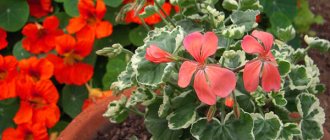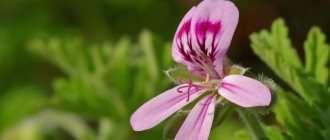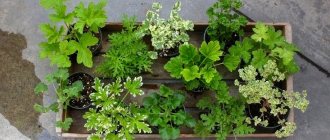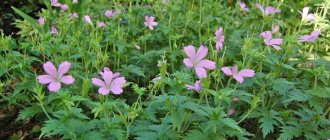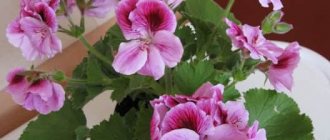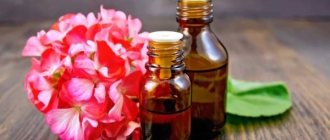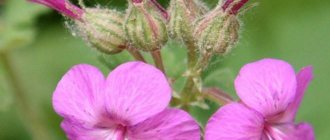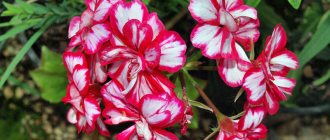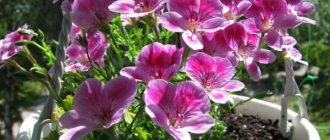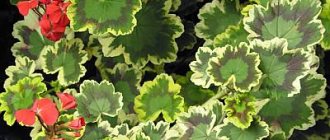Rosebud geranium is a plant that has luxurious inflorescences reminiscent of a bush rose.
The color of the buds is very different: pink, white, red, blue.
There are more than 200 species of this flower. All of them are highly decorative.
The homeland of rosebud geranium is Africa. Geranium became widely known in the 18th century - first in England, then in Europe and Russia.
Rosebud geranium (or rosebud geranium) was obtained by random mutation at the end of the 19th century in France. She inspired flower growers to breed such geraniums in different groups, resulting in varieties of zonal, ivy-leaved and dwarf rosebud geraniums.
Almost all geraniums have a specific smell due to the high content of essential oils.
Modern breeders have developed varieties with odors:
- roses;
- lemon;
- chocolate;
- pine needles;
- lavender.
Oils are widely used in medicine and cosmetologists. Geranium is able to purify the air from pathogenic bacteria and saturate the room with phytoncides.
Botanical description and history
The first mention of the subgroup was published in an article in the Journal of the Royal Horticultural Society in 1876. Although you can find information that in 1652, interested botanist enthusiasts discovered geraniums off the southwestern coast on an excursion around the area; subsequently, they were taken to Europe. Initially, they were grown in greenhouses in Holland, and then in England.
There is an opinion that the flower has healing powers . It is used as an anthelmintic and a remedy for dysentery and diarrhea.
The genus of geranium has a fairly ancient pedigree and it is impossible to determine the exact homeland of the plant; it is a known fact that most of the varieties of the flower are usually attributed to Africa.
Popular varieties of pink pelargonium
Popular varieties of this group include Bornholmpelargon . Its inflorescences look like miniature bouquets of roses. Bornholm has a red color and smooth textured petals. The buds open quite slowly, but in the future this is compensated by prolonged flowering. The main difference from other red flowers of this species are the leaves; they are covered with a pattern that visually represents a fine mesh. There is very little information about this type of geranium.
A fairly well-known variety of geranium is RosebudRed , it attracts attention with large double “roses” of scarlet color, with a relatively compact size of the plant itself, a very harmonious structure of the bush, practically does not require shaping.
The geranium "Rosita" (PAC Viva Rosita) is very beautiful . This is a fairly new variety, which appeared in 2011 and is distinguished by large and bright flowers that look like red roses.
Another popular species is the royal geranium . It was originally brought to Europe at the end of the eighteenth century from South Africa. Geranium has taken root not only in our gardens, but also in a pot on the window. It is a small bush with rich dark green stems hanging down.
At home, the plant usually reaches a height of 60-80 cm. Among this species, there are mainly geraniums with double flowers, with incredibly rich colors, their buds reach sizes of about 20-25 cm. The color of double flowers varies from light pink shades to rich peach
A distinctive feature of royal pelargonium is a darkened oval spot on each petal.
We recommend reading about how to care for other varieties of geranium, namely:
- blood red Max Fry;
- Himalayan Plenum;
- Black velvet;
- ampelous;
- white;
- fragrant;
- room;
- hybrid;
- Rosanna;
- Angel.
Description
A plant from the geranium family. Perennial evergreen subshrub up to 1 meter in height. The stems are branched, semi-lignified, succulent, brittle, densely pubescent. The leaves are alternate or opposite, round, heart-shaped, deeply divided, on long petioles, with two stipules at the base of the petiole. The flowers are pink, 5-petalled, with dark stripes on the two upper petals, collected in 8-12 inflorescences. There are 10 stamens. There are 5 capsules, each of which contains one seed. Blooms from June to October. There are more than 400 species of this plant.
It grows wild in South Africa. In its homeland, there are almost no frosts and the geranium turns into a branched shrub up to 2 meters in height, at - 3 the geranium freezes, at - 6 it freezes out from the roots. Geranium is cultivated in France, Algeria, and Spain.
Photo
Below you can see photos of rose-flowered geraniums in red, pink and other shades. RosebudRed
"Rosita" (PAC Viva Rosita)
Bornholmpelargon
Royal geranium
Planting Tips
Geranium, which blooms with roses, is a perennial plant, but in the middle zone it is subject to freezing.
Lighting and location
Pink geranium can be planted not only in the garden, but also at home.
The main thing is that the plant is not located in a place where the air temperature is below 10 degrees. It is preferable to plant this type of geranium in shaded areas or choose partial shade. An air temperature of 15 degrees is preferable for plant growth and development.
Soil requirements
In order for the plant to enjoy flowering throughout the summer season, it is necessary to provide acceptable conditions for this. The soil is selected with a neutral, slightly oxidized reaction . It is preferable to choose store-bought soil with a pH of 5.5-6.5. The soil should be light, slightly loosened, and the presence of peat and sand in it will have a positive effect on the plant. In autumn, do not forget to dig up the soil and add mineral fertilizers and humus.
Recommendations for propagation of rosebud geranium
Rosebud geranium can reproduce in two ways - by cuttings and seeds.
Seeds
Seeds are sown in a nutrient substrate with a depth of 5-10 mm and placed in a warm place. They will hatch within 1 week. Plants can be picked at the stage of appearance of 2 true leaves. Plants are planted in permanent places 3-4 weeks after the appearance of the first shoots. Since using the seed method, new plants do not inherit all the properties of the parent, it is better to propagate rosebud geranium by cuttings.
Home care
Unfortunately, geranium is susceptible to a number of diseases and pests , the most popular of which are the following:
- Flower mold . Due to the fact that geranium has a lush cap of flowers, this exposes it to the risk of gray mold developing on it. To prevent the death of a flower, it is necessary to immediately remove flowers covered with mold before it reaches the plant stem.
- Edema . Excessive watering or high humidity causes the plant's leaves to begin to look swollen and deformed, with growths predominating on the underside of the leaf.
- Leaf spot . The most common problem with geranium leaf spot is fungus and bacterial infections, which can cause the stem to turn black. Often occurs due to waterlogging of the soil. Moderate watering and good air circulation will help solve or prevent the problem.
- Slugs and snails . Snails create damage to the plant by feeding on leaves and stems. Gravel scattered around planted flowers can save your plant.
- Rust . A specific disease, often unique to geraniums, often puts the plant in danger. With heavy damage, it seriously undermines the health of the plant and disrupts the attractiveness of flowering. It is a brown-yellow formation, mainly located on the back of the leaves. To treat a plant, first of all it is necessary to remove already damaged parts of the geranium and treat the plant with a solution with a fungicide.
Caterpillars . During the summer months, when the caterpillar is especially active, pollinate the plant with a solution of a systemic insecticide. This will preserve the original appearance and prevent the unpleasant appearance of chewed leaves.- Viruses . The virus that affects geraniums is leaf curl and is transmitted to plants with contaminated soil. There is only one solution to the problem; all plants exposed to the virus must be destroyed.
- Black leg . This disease is localized mainly in the area of cuttings and on young plants. The blackening of the stem starts from the ground level, the leaves begin to dry and wither. The result leads to the death of the plant. To avoid this outcome, it is necessary to monitor the soil and take cuttings only from healthy parents.
Despite this, the flower can be called unpretentious. A plant of this type has a fairly strong immunity, but it is still better to prevent a disease that can have a detrimental effect on geranium.
The mixture for feeding geraniums should consist of a ratio of 4:2:2:1:1 (turf soil, peat, humus, coarse sand and perlite).
The plant prefers moderate watering, but care must be taken so that the soil does not dry out. Excessive watering can lead to rotting of the roots.
There is information that when watering, you should avoid getting moisture on the flower stems, because of this they lose their attractive appearance and can rot. According to gardeners, this is a misconception. Do not forget that the plant dies from dust, so in any case you cannot avoid contact with moisture on the stems and petals. Everyone wants their plant to look full of life and delight with its beauty, so you should not blindly believe unjustified myths that can significantly spoil the quality of your pet.
In winter, rose-shaped geranium should be protected as much as possible from watering and fertilizers, and kept dormant at a temperature of +10 to +15 degrees. At this time of year it looks unattractive, there is absolutely no flowering, the stem is bare, and the leaves are yellow.
Pruning outdoor and indoor pelargoniums
Formative pruning is necessary. For outdoor pelargoniums, a sanitary procedure is recommended at the end of autumn, when the plant stops blooming. It is completely cut off to a “stump” and left to winter in a cool room. In indoor perennials, elongated stems are cut off, leaving small branches up to 10-15 cm long. The cut shoots can be used for vegetative propagation of pelargoniums by cuttings.
Use complex compounds as fertilizers. Suitable fertilizer for home flowering plants. During the flowering period, focus on potassium and phosphorus. Under no circumstances use fertilizers that contain a high nitrogen content, otherwise pelargonium will not bloom and will begin to grow strongly.
It is not recommended to spray the plant. There is an opinion that water on leaves is the cause of gray mold and rot. But, in fact, the main cause of this disease lies in dust and dirt. Dirt can be removed as needed with a damp cloth.
